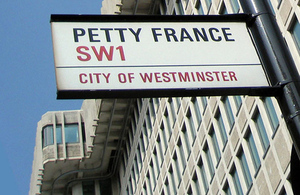-
Minister to question experts at global ‘Action on Pre-eclampsia’ meeting
-
Maternal mortality now occurs in fewer than 1 in 10,000 pregnancies, but the disparity between Black women and White women has widened in the past decade and we still lose more than 1000 babies per year to pre-eclampsia
The Minister for Equalities, Kemi Badenoch, will today [12 November] attend the annual Expert Meeting held by Action on Pre-Eclampsia, speaking to frontline clinicians and specialists from around the world on pre-eclampsia post COVID-19.
She will set out what the Government has been doing on maternal health, and question the experts on how to tackle pre-eclampsia and protect women and their babies.
It is safer to have a baby in the UK than it was 10 years ago, and the UK has one of the lowest rates of maternal mortality in the world. Tragic maternal deaths now occur in fewer than 1 in 10,000 pregnancies.
But evidence shows that black British mothers are five times more likely to die in pregnancy or six weeks after childbirth, than white women. Women of mixed ethnicity have three times the risk, and Asian women almost twice the risk. Ethnic minority women are also at an increased risk of having a pre-term birth, stillbirth, neonatal death or a baby born with low birth weight.
The Minister will say at the event: “there is a need to debunk the myth that all complications and fatalities are due to childbirth, when it is pre-existing health conditions like heart disease, diabetes, and mental health that largely explain the disparities.”
She will also emphasise that we need to shift the conversation to avoid misleading black women into thinking that giving birth is unsafe, whilst emphasising the importance of personal health and fitness, and presenting early to doctors, even during the pandemic.
Minister for Equalities, Kemi Badenoch, said:
“This year I returned from maternity leave after having my third child, so this is a topic that is very close to my heart.
“The UK is one of the safest places in the world to give birth and clinicians manage pre-eclampsia well. Seeking care before and throughout pregnancy is important and we want all women to have the access and confidence in this care the NHS provides. Particularly in a pandemic.
“Although maternal deaths are fortunately very rare, behind these tragic statistics, there are devastating consequences for families and children, so it is vital that we tackle this complex and concerning issue.”
Marcus Green, CEO of Action on Pre-eclampsia, said:
“Disparities in outcomes for pregnant women are complex, even more so in the UK which remains one of the safest countries for a woman to give birth. We need to break down the barriers to ensure all women get the care they need. It is fantastic that the Minister used this occasion to engage with experts in pre-eclampsia which remains a leading cause of maternal mortality and leads to the unnecessary death of over 1000 babies a year.”
Government is committed to supporting all pregnant women and their children. The Minister for Equalities co-hosted a roundtable on maternal mortality rates for ethnic minority women with Health Minister Nadine Dorries in September.
At the roundtable the Ministers heard expert evidence and listened to recommendations from top academics, frontline midwives and healthcare professionals, with the goal of developing joint solutions to benefit pregnant women and their babies.
Measures have been taken across the health services to protect women, with an aim to halve stillbirths, maternal mortality, neonatal mortality, and serious brain injury by 2025:
-
NHS England has provided funding for Placental Growth Factor testing which detects the likelihood of a woman developing pre-eclampsia.
-
Government has also set up a new model of community hubs, which bring a range of perinatal and sometimes intrapartum care services together in one setting closer to women’s homes to identify potential problems sooner. They have been opened across the country, with more than 100 new hubs open as of December 2019.
-
Recommendations from the landmark National Maternity Review: Better Births are being implemented through Local Maternity Systems – bringing together the NHS, local authorities and other local partners to ensure mother and baby receive seamless care.
-
The National Health Service has also launched a new phase of its ‘Help us Help You’ campaign that focuses on maternity services. This campaign reminds pregnant women about the importance of attending check-ups, contacting their midwife or maternity team when something doesn’t feel right, and reassures them that the NHS is here to see them safely.
Vijya Varshani, whose baby died because of pre-eclampsia, said:
“My son was taken from us by pre-eclampsia. Being a mum is something I have always dreamed of and it felt like my world came crashing down on me and all my dreams were shattered.
“On the evening of 26th September 2012 everything stopped around me, to be told my baby had no heartbeat and was gone. I had never felt so alone and helpless, the numbness that went through me and to have to make the call to inform my husband that our baby had gone was heart-breaking.
“Action on Pre-eclampsia (APEC) helped me so much with getting through the loss of my son, I was put in touch with experts who could help counsel me and see a light at the end of the tunnel. I remember being so scared about having another child and being able to speak with an expert helped me get through this phase. Without the help of APEC I would have always lived with the same questions; What did I do wrong? What if?”
Given that COVID-19 has fundamentally changed the way that women access maternity services, the National Maternity Safety Champion and Chief Midwifery Officer for England gave a four-point plan for all maternity services in England to follow.
That includes increasing support for at-risk pregnant women, tailoring communications to reassure ethnic minority women, ensuring that hospitals discuss vitamin supplements and nutrition in pregnancy with all women, and ensuring that all providers record on ethnicity on maternity information systems.
Notes to editors
-
Action on Pre-eclampsia (APEC) aims to raise public and professional awareness of pre-eclampsia, improve care, and ease or prevent physical and emotional suffering caused by the disease.
-
APEC is a charity registered in the UK. They run a helpline and provide information to members of the public who are affected by pre-eclampsia – be this pregnant women, their family and friends and anyone worried about pre-eclampsia. They run study days for midwives and health professionals who work with pregnant women, providing expert training on detection and management of pre-eclampsia. They also facilitate a unique expert referral service, whereby women can be referred by their GPs to an expert on pre-eclampsia in their area. APEC also provides leaflets to hospitals and maternity units informing women about pre-eclampsia and the importance of antenatal care.
-
From 2015–2020, National Institute for Health Research (NIHR) programmes invested £59.8 million on 61 awards conducting research into miscarriage, premature birth and stillbirth. Additionally, the NIHR Policy Research Programme funds a Policy Research Unit dedicated to Maternal and Neonatal Health and Care research (PRU-MHC) (2019-2023) based at the National Perinatal Epidemiology Unit, University of Oxford and led by Professor Jenny Kurinczuk.
Case study
Vijya Varshani’s full story
My name is Vijya Varshani and this is my story of pre-eclampsia and how my son was taken from us by this condition.
Being a mum is something I have always dreamed of and it felt like my world came crashing down on me and all my dreams were shattered.
In early May 2012 we discovered that I was pregnant with our first child and I couldn’t have been more excited about it.
I was always made to believe that carrying a child was the most amazing experience and enjoyable time but my pregnancy was not at all what I expected. In the early stages I had bleeding and was advised I may have suffered a miscarriage but the scan revealed otherwise and that was the first time I saw my baby.
The pregnancy progressed and I had a scan at 13 weeks and everything was going well but as weeks went by I started to experience severe headaches and my blood pressure had started to rise. I was put on blood pressure medication to try to bring this under control.
At my 20 week scan I was told that my baby was smaller than what was normal at this stage of the pregnancy, as was referred to have growth scans. My blood pressure was monitored weekly and I was told I had early onset of pre-eclampsia.
I was feeling very ill with severe headaches, getting very bad swelling on my feet, flashing lights before my eyes.
At 24 weeks of my pregnancy I was admitted into hospital with very high blood pressure and protein in my urine tests I was kept in hospital in the high dependency unit I was stabilised and was able to move to another hospital where they would be able to take better care.
I was told by the doctors that I would not be able to go home until the baby was born; it was frightening with it being so early in my pregnancy, everyday I prayed for the safe arrival of my baby.
On the evening of 26 September 2012 everything stopped around me, to be told my baby had no heartbeat and was gone. I had never felt so alone and helpless, the numbness that went through me and to have to make the call to inform my husband that our baby had gone was heart-breaking.
At 9:21pm on 27 September 2012 our son Krishan Priyesh Varshani was born sleeping at just 27 weeks of my pregnancy.
After the loss of my son I was determined that I wanted to help raise more awareness of this condition as personally having gone through this I was asked by many family members and friends what this condition was.
We decided to do a fundraiser and came in contact with APEC and whom we decided we would do our fundraising for.
APEC helped me so much with getting through the loss of my son, I was put in touch with experts who could help counsel me and see a light at the end of the tunnel.
I remember being so scared about having another child and being able to speak with an expert helped me get through this phase. Without the help of APEC I would have always lived with the same questions; What did I do wrong? What if? The staff that work for APEC are always so warm and welcoming to speak with. I was never afraid to pick up the phone or send an email to them.
I am now a mum to two lovely boys aged 6 years old and 3 years old. My family is complete.


